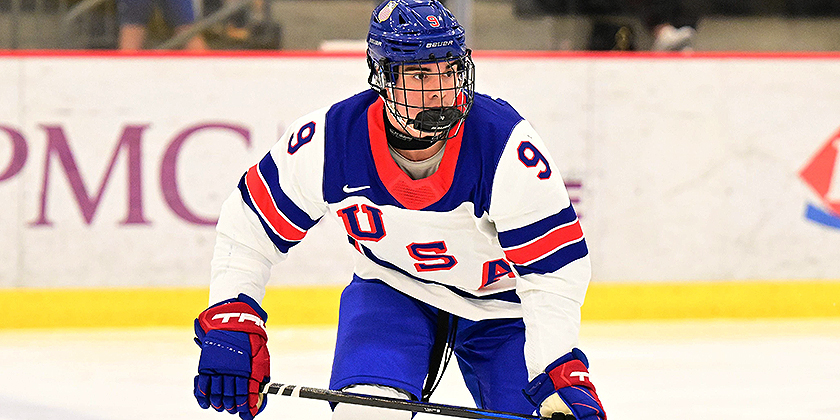
Jack Murtagh (LW, L, 6’1″, 200, NTDP U18, 08/22/2007, Boston University)
Jack Murtagh as a top-line power-wing with a strong technical foundation playing for USA Hockey’s U18 NTDP team. He effectively reads plays, intercepts breakouts, and creates scoring opportunities through his speed, agility, and hand-eye coordination. His ability to finish plays with precision is notable. However, there are areas for improvement, particularly in defensive play. While size can be an asset at times, Murtagh’s hesitation to utilize it effectively and his tendency to not initiate physical battles may impact his overall game. Additionally, his lack of aggression in defending is an element to his game to monitor. Despite these weaknesses, Murtagh’s skating ability and ability to create space on the ice are significant assets. With continued development and growth, he has the potential to become a regular middle-six National League forward.
Why Jack Murtagh Should Be an NHL Draft Pick:
- Frame, Skating & Tools Translate to the Next Level
At 6’1”, 200 lbs, Murtagh possesses the prototypical NHL winger frame. He skates well, showing linear speed, a strong glide, and balance when in motion. His ability to separate in open ice and attack defenders wide stands out. Murtagh scores in transition and has demonstrated a clear ability to create clean zone entries using pace and puck protection. His 2.5 Grade “A” scoring chances per game and 17% conversion rate highlight a player who consistently gets to dangerous ice and finishes above average. - Smart Defensive Off-Puck Reads & Offensive Awareness
Murtagh anticipates breakouts well and consistently intercepts poor clears or transition passes. He understands where to position himself off-puck to create space or close on vulnerable defenders. His 3.5 takeaways per game and 1.92 loose puck recoveries after shots are both elite indicators of game sense, timing, and offensive zone anticipation. He has the skill to make a play when the puck lands on his stick. - Growth as a Distributor
While his USHL line shows modest numbers (17 points in 21 games), Murtagh has shown he can create offense for teammates with pace and deception. His passes tend to have purpose, and when he keeps it simple, he finds the tape. At the USHL level, he improved to 88% pass completion—a sign of calmness under pressure—and he’s generating 0.67 primary passing assists per game. - Pro-Level Snap Shot & Puck Skills
Murtagh owns a technically sound release. His mechanics don’t need a rebuild. He generates good velocity, and when he’s in rhythm, he has a true pro-caliber snap shot that can beat goalies from the dots. His 5.8 shot attempts per game and 3.7 shots on goal show that he’s not afraid to shoot—though he needs to clean up the inefficiency (more on that below).
Why Jack Murtagh Should Not Be an NHL Draft Pick:
- Size Is Not Yet a Functional Asset
Despite a 6’1”, 200-lb frame, Murtagh wins just 42% of 50/50 battles in NTDP games—and just 32% in USHL matchups. That is no doubt something to watch closely. We would like to see him assert himself more often physically, finish checks that will wear down defenders (0.77 hits given per game), and we would like to see him drive his legs more consistently through contact to draw penalties (0.31 drawn per game). He’s big, but his game is still developing its bite—which is an area he will need to be in a projected role that may not include top-line power play duties at the pro level. - Turnovers and Puck Management Are a Concern
The 7 giveaways per game (NTDP) and 5.7 per game (USHL) show a player forcing plays into pressure or misjudging passing windows. His 83% pass completion (NTDP) is below average for a top-line player and correlates with inconsistent decision-making. While he does create chances, he’s not yet protecting pucks or making enough simple, clean plays consistently. - Shot Inefficiency & Blocked Attempts
For a shoot-first winger, Murtagh’s 1.38 shots blocked per game is far too high—rising to 1.56 vs. USHL competition. He telegraphs releases and needs to add deception and variability to his shot angles. These are fixable technical skills, but it signals that his shot isn’t as dangerous as his volume might suggest. - Limited Defensive Commitment & Low PK Trust
He’s barely used on the penalty kill (0:01/game) and doesn’t consistently recover deep defensively or win pucks along the wall. He’ll extend with an active stick in the neutral zone, but his hesitancy to engage physically and his lack of defensive urgency inside his own blue line raise questions about the maturity of his overall game.
Projection & Recommendation:
Draft Range: Late 2nd to Early 4th Round
NHL Projection: Middle-six scoring winger with power-play upside if strength, puck protection, and defensive play continue to develop
Comparable: Ross Colton
Final Take:
Jack Murtagh owns NHL size, a clean skating stride, and high-end offensive instincts—particularly off the puck and in space. He creates chances, anticipates plays, and can finish. However, his lack of functional strength, inconsistency in physical engagement, puck management, and defensive habits keep him from being a sure-thing NHL projection.
Recommendation: Murtagh should be considered in the late second-to-early third rounds of the draft. He must continue developing his strength, become harder to play against, and reduce the decision-making errors to reach his potential as an NHL-level offensive contributor. When those areas click, you’re getting a consistent middle-six winger with power play utility and match-up potential.
Photo credit: Dan Hickling/Hickling Images
